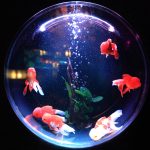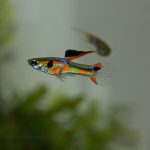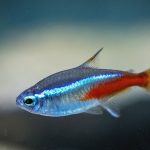The Ultimate Guide to Keeping Platies in Your Aquarium: Appearance, Behavior, Care, and More
Introduction
Keeping platies in your aquarium can be a rewarding and enjoyable experience. These colorful and lively freshwater fish are known for their peaceful nature and ease of care, making them a popular choice among both beginner and experienced fishkeepers. In this ultimate guide, we will cover everything you need to know about keeping platies in your aquarium, from tank setup and water parameters to feeding and breeding. Whether you’re a seasoned hobbyist or a newcomer to the world of fishkeeping, this guide will provide you with valuable insights to ensure the well-being and happiness of your platies.
1. Getting to Know Platies
1.1 What are Platies?
Platies (Xiphophorus maculatus) are small, brightly colored freshwater fish native to Central America. They belong to the Poeciliidae family and are known for their vibrant coloration, peaceful temperament, and ease of care. Platies are available in a wide range of colors and patterns, making them a popular choice among aquarists who appreciate their beauty.
1.2 Popular Platies Varieties
There are numerous platy varieties available in the aquarium trade, each with its unique color patterns. Some popular varieties include the Red Wagtail Platy, Mickey Mouse Platy, Tuxedo Platy, and Blue Moon Platy. The variety you choose will depend on your personal preference and the overall aesthetics of your aquarium.
2. Setting Up the Perfect Aquarium
Creating a suitable environment is crucial for the health and well-being of your platies. Here are some key considerations when setting up your aquarium:
2.1 Choosing the Right Tank Size
Platies are active swimmers and require sufficient space to thrive. A tank with a minimum capacity of 10 gallons is recommended for a small group of platies. However, larger tanks provide more stability and allow for a greater number of platies.
2.2 Selecting Suitable Substrate and Decorations
A fine gravel or sand substrate is ideal for platies, as it mimics their natural habitat and allows them to forage and explore. Adding plants, rocks, and driftwood not only enhances the aesthetics of the tank but also provides hiding spots and territorial boundaries for your platies.
2.3 Setting up the Filtration System
A reliable filtration system is essential to maintain water quality in the aquarium. Platies are sensitive to poor water conditions, so a filter that provides mechanical, biological, and chemical filtration is recommended. Make sure to choose a filter suitable for your tank size and regularly clean or replace the filter media.
2.4 Establishing the Ideal Water Parameters
Platies thrive in a slightly alkaline to neutral pH range between 7.0 and 8.0. The water temperature should be maintained between 72°F and 78°F (22°C to 26°C). It’s important to monitor these parameters regularly using a reliable test kit and make adjustments as necessary.
3. Acclimating and Introducing Platies
Proper acclimation and introduction of platies to their new environment are crucial to reduce stress and ensure a smooth transition. Follow these steps for a successful introduction:
3.1 Preparing for Acclimation
Before introducing platies to the aquarium, turn off the lights and float the sealed bag containing the fish in the tank for about 15-20 minutes. This will allow the water temperature inside the bag to gradually adjust to that of the tank.
3.2 Proper Introductions to the Aquarium
Once acclimated, open the bag and carefully release the platies into the tank. Avoid adding water from the bag into the aquarium, as it may contain harmful substances. Allow the fish to swim out of the bag on their own, ensuring a stress-free transition.
4. Feeding and Nutrition
Proper nutrition is vital for the health and vitality of your platies. Here are some guidelines for feeding your fish:
4.1 Understanding the Dietary Needs of Platies
Platies are omnivorous and have a varied diet. They require a combination of high-quality flake or pellet food as their staple diet. Additionally, supplement their diet with live or frozen foods such as brine shrimp, daphnia, or bloodworms to provide essential nutrients.
4.2 Choosing the Right Fish Food
Select a high-quality fish food specifically formulated for platies. Look for options that provide a balanced mix of proteins, fats, and carbohydrates. Ensure that the food is suitable for their size and easy for them to consume.
4.3 Establishing a Feeding Schedule
Feed your platies small amounts of food two to three times a day. Overfeeding can lead to health issues and poor water quality. Monitor their eating habits and adjust the quantity accordingly.
4.4 Supplementing with Live and Frozen Foods
To enhance their diet, offer live or frozen foods as occasional treats. These foods not only provide additional nutrients but also stimulate natural foraging behavior in platies.
5. Tank Maintenance and Water Quality
Maintaining a clean and stable environment is crucial for the well-being of your platies. Follow these maintenance guidelines:
5.1 Regular Water Changes
Perform regular partial water changes of 20% to 30% every two weeks. This helps remove accumulated toxins and replenish essential minerals in the aquarium.
5.2 Monitoring Water Parameters
Regularly test the water parameters using a reliable test kit. Keep an eye on parameters such as pH, ammonia, nitrite, and nitrate levels to ensure they remain within the appropriate range for platies.
5.3 Maintaining Optimal Water Quality
In addition to water changes, proper filtration and regular substrate vacuuming are essential for maintaining optimal water quality. Remove any uneaten food or debris from the tank to prevent water contamination.
6. Platies Breeding and Reproduction
Platies are known for their prolific breeding habits. If you’re interested in breeding them, follow these steps:
6.1 Understanding Platies Breeding Behavior
Male platies are known for their courting behavior, displaying vibrant colors and chasing the females. Females are livebearers, meaning they give birth to fully formed fry instead of laying eggs.
6.2 Setting Up a Breeding Tank
To promote successful breeding, set up a separate breeding tank with dense vegetation or a breeding trap. This provides a safe space for pregnant females to give birth and protects the fry from being eaten by other fish.
6.3 Caring for Fry (Baby Platies)
Once the fry are born, separate them from the adult fish to prevent predation. Feed them with finely crushed flake food or specialized fry food several times a day. As they grow, gradually introduce larger food particles.
7. Common Health Issues and Care
Platies are generally hardy fish, but they can still be susceptible to certain health issues. Here are some common problems and tips for care:
7.1 Identifying Common Health Problems
Keep an eye out for signs of common health issues such as fin rot, ich, or swim bladder disorders. Symptoms may include changes in behavior, appetite, or physical appearance. Promptly address any health concerns to prevent further complications.
7.2 Maintaining a Healthy Environment
Maintaining optimal water quality, providing a balanced diet, and avoiding overcrowding are crucial for preventing health problems in platies. Regularly monitor water parameters and ensure a stress-free environment.
7.3 Seeking Professional Help
If you notice persistent health issues or are unsure about the appropriate treatment, consult with a knowledgeable aquatic veterinarian or seek advice from an experienced fishkeeper.
8. Compatibility and Tankmates
When selecting tankmates for your platies, consider their peaceful nature and compatibility. Here are some factors to consider:
8.1 Choosing Compatible Tankmates
Platies are generally peaceful and get along well with other peaceful community fish. Good tankmates for platies include tetras, guppies, mollies, and peaceful bottom-dwellers like Corydoras catfish.
8.2 Avoiding Aggression and Conflict
Avoid keeping platies with aggressive or fin-nipping fish, as they may harass or damage the fins of the platies. Aggressive species like cichlids or larger predatory fish should be avoided to ensure a harmonious tank environment.
9. Conclusion
Keeping platies in your aquarium can be a delightful and rewarding experience. With their vibrant colors, peaceful nature, and easy care requirements, they are an excellent choice for both beginner and experienced fishkeepers. By following the guidelines in this ultimate guide, you can create a suitable habitat for your platies, maintain their health, and enjoy their beauty for years to come.
FAQs (Frequently Asked Questions)
10.1 Can platies live in a community tank?
Yes, platies are peaceful fish that can thrive in a community tank with compatible fish species. Just ensure that the tankmates are peaceful and won’t pose a threat to the platies.
10.2 How long do platies live?
On average, platies can live for 2 to 3 years. With proper care, a healthy and well-maintained environment, and a balanced diet, they may even live longer.
10.3 Can platies survive in a freshwater or saltwater aquarium?
Platies are freshwater fish and cannot survive in a saltwater aquarium. They require a freshwater environment with specific water parameters to thrive.
10.4 Are platies suitable for beginners?
Yes, platies are considered beginner-friendly fish due to their hardiness, ease of care, and peaceful nature. They can be a great choice for those new to fishkeeping.
10.5 How often should I feed my platies?
It’s recommended to feed your platies small amounts of food two to three times a day. Monitor their feeding behavior and adjust the quantity as needed to prevent overfeeding.
In conclusion, keeping platies in your aquarium can bring joy and beauty to your aquatic environment. By following the guidelines in this ultimate guide, you can ensure the well-being of your platies, create a vibrant and engaging habitat, and enjoy the fascinating behaviors of these wonderful fish. With their colorful personalities, platies are sure to be a delightful addition to any aquarium setup.




